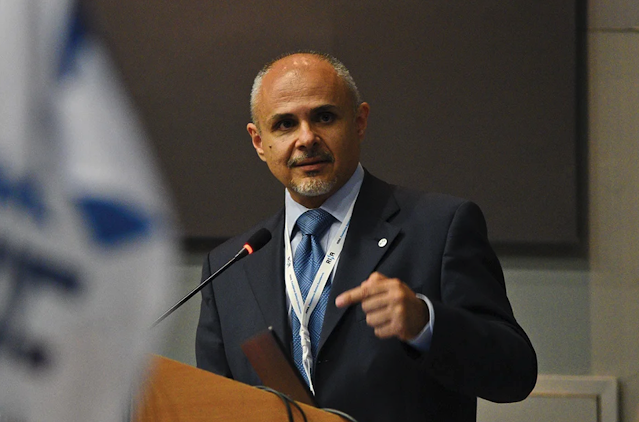| John Kokarakis, Technical Director of SEEBA Zone at Bureau Veritas |
Concerted action by all industry stakeholders is needed to overcome the barriers of knowledge gaps and lack of access to financial resources, leaping forward with decarbonization.
Pillars are energy efficiency, low-carbon fuels, feedstocks, energy sources, and overboard carbon capture and storage. A global behavioral revolution is needed and possibly more dramatic legislation reforms. The changing regulatory landscape currently affecting shipping is decarbonization, aiming at introducing zero-carbon ship propulsion systems, and digital technology in ships, companies, and logistics following a complex journey. Digitalization will provide means to measure energy efficiency. To reach the goals of decarbonization, shipping will have to start transitioning to new and alternative fuels. Most likely, there will not be one single ‘fuel of the future’.
For short-sea shipping, like ferries, electrification is a possibility and hybrid and electric ferries already exist in Norway, Denmark, and Sweden. There’s effectively been exponential growth in the deployment of electric ferries over shorter distances, but it’s not an option for deep-sea vessels, due to the size of batteries that would be required.
What are the options for powering deep-sea vessels?
The simplest solution that’s been identified so far is a form of liquid fuel to replace heavy fuel oil. Biomass-derived fuels, like biofuel or biogas, are explored. Hydrogen and synthetic non-carbon fuels, like ammonia, for example, are derived from renewable energy or fossil fuels combined with OCCS (onboard carbon capture & storage). Synthetic fossil fuels, like e-methanol, can be carbon-neutral based on the production process. Biomass-derived fuels are being tested as drop-in fuels on certain routes because they can burn on existing combustion engines. But they’re most likely only a transition solution. The production of biomass competes with food production. And, as other industries transition away from fossil fuels, the competition is going to be high – and it’s not one that shipping is necessarily going to win. So, hydrogen and other synthetic non-carbon fuels seem like the highest potential long-term solution. Financial institutions are helping to steer the industry towards a zero-carbon future. New fuels such as ammonia are promising, but they may reach $1,300-1,500 per ton, compared to $300-500 per ton for fossil fuels.
IMO has been criticized for inaction. As a reaction to the inaction, other regulatory initiatives have emerged. Notable examples are the inclusion of shipping in the EU’s emission trading scheme, the Poseidon Principles for responsible ship finance, and the Clydebank Declaration for green shipping corridors to promote the uptake of alternative fuels. Leading actors are developing new vessels using fuels produced without carbon emissions. Shipping is inherently a global industry – and thus its decarbonization must be addressed globally. If the IMO doesn’t reach an agreement on global rules now, we are facing an inadequate patchwork of different rules in different regions.
The shipping sector needs political support to reach net zero emissions. Policymakers will need to provide supportive regulatory environments to ensure that zero-emissions shipping can become competitive. The necessary decarbonization catalyst is legislation by international regulators and national governments that makes zero-carbon shipping and fuel production commercially viable.
As global trade flows increase, serving a more prosperous world, emissions from shipping could grow between 50% and 250% by 2050 if no action is taken. If shipping were a country, it would be the world’s sixth-biggest greenhouse gas emitter. Halving shipping emissions by 2050 requires $1.4 trillion in investment. The investments are ship-related like engines, on-board storage, energy-efficiency technologies and land-based in the production of low-carbon fuels, and storage and bunkering infrastructure. The lion’s share is required in the land-based infrastructure and production facilities. The scale of shipping decarbonization will catalyze energy transition in all sectors of the world ecosystem, thus opening Pandora’s box into a trillion-dollar market opportunity.
The responsibility to decarbonize the shipping ecosystem includes cargo owners and financiers. Decarbonization of shipping can be reached with a large-scale collaboration. Investors and insurers will have to become comfortable with new technologies. Shipping, a hard-to-abate sector, mandates close collaboration with the energy value chains, infrastructure, and finance sectors, with backing from government and international organizations.
The transition will only be possible if shipping draws and develops the expertise of the broader maritime workforce. New opportunities will be created across the value chain, in the production of zero-emission fuels for example. Reskilling, upskilling, and skills transfer must be incorporated into the transition as shipping moves to new fuel sources. Shipping companies must enable greater diversity and inclusion and develop new skills to achieve a just transition. This includes the implementation of ambitious ESG frameworks, such as the 10 Principles of the UN.
As a first step, it is imperative to have commercially viable zero-emission vessels operating in deep-sea trade by 2030. A UMAS study for the Getting to Zero Coalition reports that a target of 5% of zero-emission fuels by 2030 means the sector is in line with the goals of the Paris Agreement. This is the tipping point limit at which zero-emission fuels become cost-competitive and their adoption accelerates. Vessels delivered around 2030 will be in operation in 2050 given their lifespan of at least 20 years. This is viable if zero-emission energy sources are competitive with traditional fuels.
Environmental performance becomes a major criterion for trade deals and negotiations. Charterers may select the vessels taking into account their environmental performance. By managing both the cargo and the ballast leg, using technology and big data, planning smarter ETA, and predicting port congestion, charterers can reduce the carbon footprint dramatically. This is translated to increased profitability since they will need fewer carbon credits. Artificial Intelligence (AI) harnesses accurate emissions calculations and predictions. AI allows shipping to rely on real-life data instead of historical averages with detailed accounting per voyage by operational activity.
A zero-emission fleet is viable if zero-emission energy sources are competitive with fossil fuels which are available, reliable, and cheap. This competitiveness gap cannot be solved on its own. New policies are needed, incentivizing shipping stakeholders to invest in new fuels and technologies. IMO must bridge the competitiveness gap between carbon-based fuels and zero-carbon energy sources with the introduction of market-based measures. The revenue from a market-based measure must support the deployment of zero-emission vessels and fuels, de-risking the pioneers and enabling investments. The transition to zero-emission shipping can go hand in hand with sustainable economic growth. Zero-emission ships require huge investments. By increasing efficiency in the sector, emission reductions can be achieved at a lower cost. The maritime shipping industry must make some big changes if it is to meet its target.
We also need to balance the environment with the social and economic aspects of sustainability. The industry consensus is that a global fuel levy will be necessary to incorporate the social cost of carbon into fuel costs. The task of decarbonizing global shipping also brings along opportunities that businesses, customers, and decision-makers must seize.
Shipping’s share of emissions grows quite significantly over time.
Can shipping achieve zero emissions by 2050? Is that an ambitious target? What needs to happen to achieve the goal of carbon-neutral shipping?
No matter what the fuels of the future will be, it will be useful to reduce the total amount of fuel needed to power global trade. More fuel-efficient transport modes, supply-chain optimization, and operational efficiency should be prioritized for their emissions-reducing potential. The 2020s must be the decade of action if we are to solve the shipping industry’s share of the global climate challenge before we reach a critical tipping point.
We need the whole system to move together for shipping decarbonization to be possible. And what’s exciting about it is shipping can be a showcase for other sectors. If shipping, a hard to abate sector, can make this transition towards carbon-neutrality, it can be possible for others. It’s just a question of working together to make it a reality. And remember the motto from Shell: Think big, start small, and scale fast.















